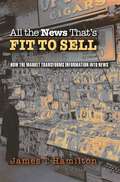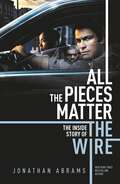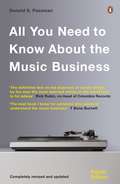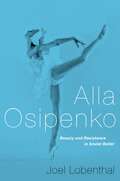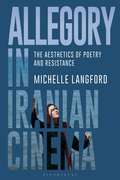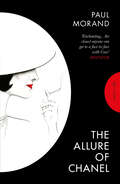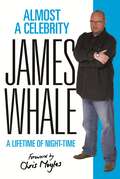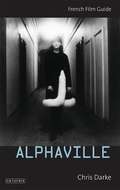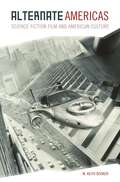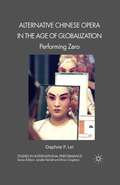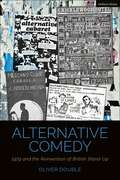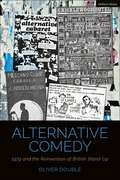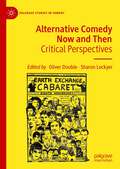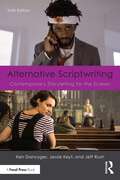- Table View
- List View
All the Best Lines: An Informal History of the Movies in Quotes, Notes and Anecdotes
by George TiffinPithy put-downs, hard-boiled snarlings, words of love and regret... All the Best Lines presents 500 memorable movie quotes, embracing both one-liners ('My name is Pussy Galore') and slices of snappy dialogue from pictures as diverse as When Harry Met Sally and Pulp Fiction. Arranged under such timeless themes as Dreams, Friends, Libido and Memories, the quotes juxtapose films and stars from every era and every genre. Dotted throughout the text are feature capsules focusing on themes and stories in the movies from Goldwynisms to Mae West, plus a generous scattering of cinema anecdotes, making the book both a joy to browse and an authoritative reference. Lavishly illustrated with full-colour photographs, All the Best Lines will delight and entertain you in equal measure, reacquainting you with your favourite movies and introducing you to some forgotten classics.
All the News That’s Fit to Sell: How the Market Transforms Information into News
by James T. HamiltonThat market forces drive the news is not news. Whether a story appears in print, on television, or on the Internet depends on who is interested, its value to advertisers, the costs of assembling the details, and competitors' products. But in All the News That's Fit to Sell, economist James Hamilton shows just how this happens. Furthermore, many complaints about journalism--media bias, soft news, and pundits as celebrities--arise from the impact of this economic logic on news judgments. This is the first book to develop an economic theory of news, analyze evidence across a wide range of media markets on how incentives affect news content, and offer policy conclusions. Media bias, for instance, was long a staple of the news. Hamilton's analysis of newspapers from 1870 to 1900 reveals how nonpartisan reporting became the norm. A hundred years later, some partisan elements reemerged as, for example, evening news broadcasts tried to retain young female viewers with stories aimed at their (Democratic) political interests. Examination of story selection on the network evening news programs from 1969 to 1998 shows how cable competition, deregulation, and ownership changes encouraged a shift from hard news about politics toward more soft news about entertainers. Hamilton concludes by calling for lower costs of access to government information, a greater role for nonprofits in funding journalism, the development of norms that stress hard news reporting, and the defining of digital and Internet property rights to encourage the flow of news. Ultimately, this book shows that by more fully understanding the economics behind the news, we will be better positioned to ensure that the news serves the public good.
All the News That’s Fit to Sell: How the Market Transforms Information into News (PDF)
by James T. HamiltonThat market forces drive the news is not news. Whether a story appears in print, on television, or on the Internet depends on who is interested, its value to advertisers, the costs of assembling the details, and competitors' products. But in All the News That's Fit to Sell, economist James Hamilton shows just how this happens. Furthermore, many complaints about journalism--media bias, soft news, and pundits as celebrities--arise from the impact of this economic logic on news judgments. This is the first book to develop an economic theory of news, analyze evidence across a wide range of media markets on how incentives affect news content, and offer policy conclusions. Media bias, for instance, was long a staple of the news. Hamilton's analysis of newspapers from 1870 to 1900 reveals how nonpartisan reporting became the norm. A hundred years later, some partisan elements reemerged as, for example, evening news broadcasts tried to retain young female viewers with stories aimed at their (Democratic) political interests. Examination of story selection on the network evening news programs from 1969 to 1998 shows how cable competition, deregulation, and ownership changes encouraged a shift from hard news about politics toward more soft news about entertainers. Hamilton concludes by calling for lower costs of access to government information, a greater role for nonprofits in funding journalism, the development of norms that stress hard news reporting, and the defining of digital and Internet property rights to encourage the flow of news. Ultimately, this book shows that by more fully understanding the economics behind the news, we will be better positioned to ensure that the news serves the public good.
All the Pieces Matter: The Inside Story of The Wire
by Jonathan AbramsThe definitive oral history of the iconic and beloved TV show The Wire, as told by the actors, writers, directors, and others involved in its creationSince its final episode aired in 2008, the acclaimed crime drama The Wire has only become more popular and influential. The issues it tackled, from the failures of the drug war and criminal justice system to systemic bias in law enforcement and other social institutions, have become more urgent and central to the national conversation. The show's actors, such as Idris Elba and Dominic West, have gone on to become major stars. Its creators and writers, including David Simon and Richard Price, have developed dedicated cult followings of their own. Universities use the show to teach everything from film theory, to criminal justice and sociology. Politicians and activists reference it when discussing policy. When critics compile lists of the Greatest TV Shows of All Time, The Wire routinely takes the top spot. It is arguably one of the great works of art America has produced in the 21st century.But while there has been a great deal of critical analysis of the show and its themes, until now there has never been a definitive, behind-the-scenes take on how it came to be made. With unparalleled access to all the key actors and writers involved in its creation, Jonathan Abrams tells the astonishing, compelling, and complete account of The Wire, from its inception and creation through its end and powerful legacy.'From the moment The Wire ended, all I have wished for is one more season. Jonathan Abrams has given us something just as valuable — the complete story of how something this wonderful, rich, and intricate came to be' - Mike Schur, creator of Parks and Recreation, Brooklyn 99 and The Good Place'The definitive dissection of television’s most politically meaningful invention' - Chuck Klosterman, New York Times bestselling author of But What if We’re Wrong? and I Wear The Black Hat'Abrams indisputably has created a thorough examination of The Wire’s conception, production, and lingering cultural afterlife' - Publishers Weekly
All the President’s Men (BFI Film Classics)
by Robert B. Ray Christian KeathleyAlan J. Pakula's political thriller All the President's Men (1976) was met with immediate critical and commercial success upon its release, finishing second at the box office and earning seven Academy Award nominations. Through a close reading of key scenes, performances and stylistic decisions, Christian Keathley and Robert B. Ray show how the film derives its narrative power through a series of controlled oppositions: silence vs. noise; stationary vs. moving camera; dark vs. well-lit scenes and shallow vs. deep focus, tracing how these elements combine to create an underlying formal design crucial to the film's achievement. They argue that the film does not fit the auteurist model of New Hollywood film-makers such as Coppola and Scorsese. Instead, All the President's Men more closely resembles a studio-era film, the result of a collaboration between a producer (Robert Redford), multiple scriptwriters, a skilful director, important stars (Robert Redford and Dustin Hoffman), a distinctive cameraman (Gordon Willis), an imaginative art director (George Jenkins) and ingenious sound designers, who together created an enduringly great film.
All the President’s Men (BFI Film Classics)
by Robert B. Ray Christian KeathleyAlan J. Pakula's political thriller All the President's Men (1976) was met with immediate critical and commercial success upon its release, finishing second at the box office and earning seven Academy Award nominations. Through a close reading of key scenes, performances and stylistic decisions, Christian Keathley and Robert B. Ray show how the film derives its narrative power through a series of controlled oppositions: silence vs. noise; stationary vs. moving camera; dark vs. well-lit scenes and shallow vs. deep focus, tracing how these elements combine to create an underlying formal design crucial to the film's achievement. They argue that the film does not fit the auteurist model of New Hollywood film-makers such as Coppola and Scorsese. Instead, All the President's Men more closely resembles a studio-era film, the result of a collaboration between a producer (Robert Redford), multiple scriptwriters, a skilful director, important stars (Robert Redford and Dustin Hoffman), a distinctive cameraman (Gordon Willis), an imaginative art director (George Jenkins) and ingenious sound designers, who together created an enduringly great film.
All Things Must Pass: The Life of George Harrison
by Marc ShapiroGeorge Harrison was always known as the 'quiet Beatle' As part of the biggest band in pop history, he took a back seat to Paul McCartney and John Lennon, but his talent shone through in the composition of classic songs such as 'Something' and 'Here Comes The Sun'. In his solo career he occasionally threatened to eclipse both John and Paul on the world stage, and he joined forces with Bob Dylan, Tom Petty, Roy Orbison and Jeff lynne to create the massively succsessful supergroup the Traveling Wilburys.However, the success of his professional life was often met by turmoil in his private life, and the loss of first wife Patti to best friend Eric Clapton, the traumatic attempt on his life by a knife wielding intruder and his final struggle against cancer meant that George Harrison's life was nothing if not dramatic.Bestselling author Marc Shapiro has exclusively interviewed friends and former colleagues of the enigmatic guitar legend. This revealing biography reaffirms Harrison's importance as an innovative and hugely talented musician and shows that, as a member of the most important band ever, as well as in his multi-faceted career after the Beatles, George Harrison was no ordinary man.
All Too Human: Laughter, Humor, and Comedy in Nineteenth-Century Philosophy (Boston Studies in Philosophy, Religion and Public Life #7)
by Lydia L. MolandThis book offers an analysis of humor, comedy, and laughter as philosophical topics in the 19th Century. It traces the introduction of humor as a new aesthetic category inspired by Laurence Sterne’s "Tristram Shandy" and shows Sterne’s deep influence on German aesthetic theorists of this period. Through differentiating humor from comedy, the book suggests important distinctions within the aesthetic philosophies of G.W.F. Hegel, Karl Solger, and Jean Paul Richter. The book links Kant’s underdeveloped incongruity theory of laughter to Schopenhauer’s more complete account and identifies humor’s place in the pessimistic philosophy of Julius Bahnsen. It considers how caricature functioned at the intersection of politics, aesthetics, and ethics in Karl Rosenkranz’s work, and how Kierkegaard and Nietzsche made humor central not only to their philosophical content but also to its style. The book concludes with an explication of French philosopher Henri Bergson’s claim that laughter is a response to mechanical inelasticity.
All You Need to Know About the Music Business: Eighth Edition
by Donald S PassmanAll You Need To Know About The Music Business - The new edition of 'the industry bible' (Los Angeles Times) by Donald S. PassmanNo one understands the music business and the changes it has undergone in recent years better than LA lawyer Donald Passman. For 20 years his book has offered detailed advice to artists and executives, novices and experts alike on how to thrive in these volatile times.This completely revised edition sets out recent developments in record deals, copyright, new technologies and film music. It also offers unique advice on how to navigate your way through the ins and outs of songwriting, music publishing, merchandising and performing. Whether you're a newcomer or an established professional, All You Need to Know about the Music Business is an essential companion. It will also be loved by readers of The Music Business and How Music Works by David Byrne.'The definitive text on the business of music written by the man the most talented artists in the world look to for advice' Ron Rubin, co-head of Columbia Records'Should be required reading for anyone planning or enduring a career in the biz' Rolling StoneDonald Passman is a graduate of the University of Texas and the Harvard Law School. For many years he has practised law with the LA firm of Gang, Tyre, Ramer and Brown, where he specializes in the music and film industries. He represents many famous music clients. He lives in LA with his wife and four children, and plays guitar and five-string banjo.
Alla Osipenko: Beauty and Resistance in Soviet Ballet
by Joel LobenthalAlla Osipenko is the gripping story of one of history's greatest ballerinas, a courageous rebel who paid the price for speaking truth to the Soviet State. She studied with Agrippina Vaganova, the most revered and influential of all Russian ballet instructors, and in 1950, she joined the Mariinsky (then-Kirov) Ballet, where her lines, shapes, and movements both exemplified the venerable traditions of Russian ballet and propelled those traditions forward into uncharted and experimental realms. She was the first of her generation of Kirov stars to enchant the West when she danced in Paris in 1956. But dancing for the establishment had its downsides, and Osipenko's sharp tongue and marked independence, as well as her almost-reckless flouting of Soviet rules for personal and political conduct, soon found her all but quarantined in Russia. An internationally acclaimed ballerina at the height of her career, she found that she would now have to prevail in the face of every attempt by the Soviet state and the Kirov administration to humble her. In Alla Osipenko, acclaimed dance writer Joel Lobenthal tells Osipenko's story for the first time in English, drawing on 40 interviews with the prima ballerina, and tracing her life from Classical darling to avant-garde rebel. Throughout the book, Osipenko talks frankly and freely in a way that few Russians of her generation have allowed themselves to. Her voice rises above the incidents as unhesitating and graceful as her legendary adagios. Candid, irreverent, and, above all, independent -- Osipenko and her story open a window into a fascinating and little-discussed world.
Alla Osipenko: Beauty and Resistance in Soviet Ballet
by Joel LobenthalAlla Osipenko is the gripping story of one of history's greatest ballerinas, a courageous rebel who paid the price for speaking truth to the Soviet State. She studied with Agrippina Vaganova, the most revered and influential of all Russian ballet instructors, and in 1950, she joined the Mariinsky (then-Kirov) Ballet, where her lines, shapes, and movements both exemplified the venerable traditions of Russian ballet and propelled those traditions forward into uncharted and experimental realms. She was the first of her generation of Kirov stars to enchant the West when she danced in Paris in 1956. But dancing for the establishment had its downsides, and Osipenko's sharp tongue and marked independence, as well as her almost-reckless flouting of Soviet rules for personal and political conduct, soon found her all but quarantined in Russia. An internationally acclaimed ballerina at the height of her career, she found that she would now have to prevail in the face of every attempt by the Soviet state and the Kirov administration to humble her. In Alla Osipenko, acclaimed dance writer Joel Lobenthal tells Osipenko's story for the first time in English, drawing on 40 interviews with the prima ballerina, and tracing her life from Classical darling to avant-garde rebel. Throughout the book, Osipenko talks frankly and freely in a way that few Russians of her generation have allowed themselves to. Her voice rises above the incidents as unhesitating and graceful as her legendary adagios. Candid, irreverent, and, above all, independent -- Osipenko and her story open a window into a fascinating and little-discussed world.
Allegory in Enlightenment Britain: Literary Abominations
by Jason J. GulyaThis Palgrave Pivot argues for the significance of allegory in Enlightenment writing. While eighteenth-century allegory has often been dismissed as an inadequate form, both in its time and in later scholarship, this short book reveals how Enlightenment writers adapted allegory to the cultural changes of the time. It examines how these writers analyzed earlier allegories with scientific precision and broke up allegory into parts to combine it with other genres. These experimentations in allegory reflected the effects of empiricism, secularization and a modern aesthetic that were transforming Enlightenment culture. Using a broad range of examples – including classics of the genre, eighteenth-century texts and periodicals – this book argues that the eighteenth century helped make allegory the flexible, protean literary form it is today.
Allegory in Iranian Cinema: The Aesthetics of Poetry and Resistance (International Library Of The Moving Image Ser.)
by Michelle LangfordIranian filmmakers have long been recognised for creating a vibrant, aesthetically rich cinema whilst working under strict state censorship regulations. As Michelle Langford reveals, many have found indirect, allegorical ways of expressing forbidden topics and issues in their films. But for many, allegory is much more than a foil against haphazardly applied censorship rules. Drawing on a long history of allegorical expression in Persian poetry and the arts, allegory has become an integral part of the poetics of Iranian cinema. Allegory in Iranian Cinema explores the allegorical aesthetics of Iranian cinema, explaining how it has emerged from deep cultural traditions and how it functions as a strategy for both supporting and resisting dominant ideology. As well as tracing the roots of allegory in Iranian cinema before and after the 1979 revolution, Langford also theorizes this cinematic mode. She draws on a range of cinematic, philosophical and cultural concepts - developed by thinkers such as Walter Benjamin, Gilles Deleuze, Pier Paolo Pasolini, Christian Metz and Vivian Sobchack - to provide a theoretical framework for detailed analyses of films by renowned directors of the pre-and post-revolutionary eras including Masoud Kimiai, Dariush Mehrjui, Ebrahim Golestan, Kamran Shirdel, Majid Majidi, Jafar Panahi, Marziyeh Meshkini, Mohsen Makhmalbaf, Rakhshan Bani-Etemad and Asghar Farhadi.Allegory in Iranian Cinema explains how a centuries-old means of expression, interpretation, encoding and decoding becomes, in the hands of Iran's most skilled cineastes, a powerful tool with which to critique and challenge social and cultural norms.
Allegory in Iranian Cinema: The Aesthetics of Poetry and Resistance
by Michelle LangfordIranian filmmakers have long been recognised for creating a vibrant, aesthetically rich cinema whilst working under strict state censorship regulations. As Michelle Langford reveals, many have found indirect, allegorical ways of expressing forbidden topics and issues in their films. But for many, allegory is much more than a foil against haphazardly applied censorship rules. Drawing on a long history of allegorical expression in Persian poetry and the arts, allegory has become an integral part of the poetics of Iranian cinema. Allegory in Iranian Cinema explores the allegorical aesthetics of Iranian cinema, explaining how it has emerged from deep cultural traditions and how it functions as a strategy for both supporting and resisting dominant ideology. As well as tracing the roots of allegory in Iranian cinema before and after the 1979 revolution, Langford also theorizes this cinematic mode. She draws on a range of cinematic, philosophical and cultural concepts - developed by thinkers such as Walter Benjamin, Gilles Deleuze, Pier Paolo Pasolini, Christian Metz and Vivian Sobchack - to provide a theoretical framework for detailed analyses of films by renowned directors of the pre-and post-revolutionary eras including Masoud Kimiai, Dariush Mehrjui, Ebrahim Golestan, Kamran Shirdel, Majid Majidi, Jafar Panahi, Marziyeh Meshkini, Mohsen Makhmalbaf, Rakhshan Bani-Etemad and Asghar Farhadi.Allegory in Iranian Cinema explains how a centuries-old means of expression, interpretation, encoding and decoding becomes, in the hands of Iran's most skilled cineastes, a powerful tool with which to critique and challenge social and cultural norms.
The Allure of Chanel (Pushkin Collection)
by Paul MorandThe story of Coco Chanel s life, as told by her to Paul MorandCoco Chanel invited Paul Morand to visit her in St Moritz at the end of the Second World War when he was given the opportunity to write her memoirs; his notes of their conversations were put away in a drawer and only came to light one year after Chanel's death. Through Morand's transcription of their conversations, Chanel tells us about her friendship with Misia Sert, the men in her life - Boy Capel, the Duke of Westminster, artists such as Diaghilev, her philosophy of fashion and the story behind the legendary Number 5 perfume...The memories of Chanel told in her own words provide vivid sketches and portray the strength of Coco's character, leaving us with an extraordinary insight into Chanel the woman and the woman who created Chanel.'It's an interesting memoir because it s all about what she thinks not what she did.' --David Patrick Columbia, The New York Social Diary'Morand was a citizen of the world, with a sharp eye and a neat turn of phras-- The Tablet'This enchanting, tiny book is the closest anyone can get to a face-to-face with Coco. It's written in her voice ('that voice that gushed forth from her mouth like lava') and in her words ('those words that crackled like dried vines'), and though it's full of lies, omissions and contradictions, there's enough raw truth in it to reflect the extraordinary woman who was Chanel, even though glimpsed shard by shard in a broken mirror.' --The Spectator'Paul Morand recaptures a WWII-era conversation between the author and the fashion icon. --Publisher's Weekly'Reads beautifully ... this enchanting book is the closest anyone can get to a face-to-face with Coco... written in her voice and in her words.'--The Spectator 'Without a doubt the best French writer of the 20th century.' Philippe Sollers'Morand was the all-round aesthete.' Nicholas Lezard, The Guardian'Admired both by Ezra Pound and by Marcel Proust as a pioneer craftsman of Modernist French prose (...) The sheer shapeliness of his prose recalls Hemingway; the urbanity of his self-destructiveness compares with Fitzgerald's; and his camera eye is as lucidly stroboscopic as that of Dos Passos. He is, like Victor Segalen, Blaise Cendrars, Valery Larbaud, and Saint-John Perse, one of the great nomads of 20th-century French literature, racing through the apocalypse with the haste and glamor of an Orient Express. It is a pity we should have had to wait this long to catch up with him.'--The New York Times;Paul Morand was born in Paris in 1888 and after studying at the Ecole des Science Politiques he joined the diplomatic corps, serving in London, Rome, Berne and Bucharest. His first collection of stories Tender Shoots (Tendres Stocks, 1921), had an introduction by his friend Marcel Proust. In a long and busy life, he found time to write poetry, novels, short stories and travel books. Morand was made a member of the Academie Francaise in 1963. He was married to the Romanian princess Helene Soutzo, and he died in 1976.
Almost a Celebrity: A Lifetime of Night-Time
by James Whale"Almost a Celebrity" is the no-holds-barred autobiography of radio megastar James Whale, a man who, for over thirty years, has never been afraid to say the unsayable. In his typically deadpan style, "Almost a Celebrity" charts James' rise to the top - with plenty of trademark rants along the way - from his Surrey childhood, where he avoided school by hanging out in Soho strip joints, through his humble beginnings in local radio, via the self-titled TV show which made his name, to his current status as late-night king of the airwaves.
Alphaville: French Film Guide (Ciné-File French Film Guides)
by Chris DarkeA striking black-and-white hybrid of film noir and science fiction, Alphaville (1965) is now one of the most enduringly popular of Jean-Luc Godard's films of the 1960s. Working without sets, special effects, or even a script, Godard created a dystopian vision of a technocratic city of the future, which resonates with filmmakers today. Alphaville pits secret agent Lemmy Caution (Eddie Constantine) against Alpha 60, the super-computer that presides over a city where weeping is outlawed, poetry goes unrecognised and the words conscience and love have ceased to exist. Lemmy's mission is to capture the renegade scientist Professor von Braun (Howard Vernon) but is complicated when he falls in love with the Professor's ravishing daughter, Natasha (Anna Karina). In this first ever exploration of Godard's masterpiece, published on the fortieth anniversary of its release, Chris Darke uncovers the film's unique combination of genres and styles and draws on new interviews with the director's collaborators to chronicle the film's production. Analysing Alphaville in its historical context, he also examines how the film in fluenced Godard's later work, as well as exploring Alphaville's afterlife in the work of other filmmakers and artists.
Altern mit Stigma: Gesellschaftliche und psychosoziale Perspektiven des Älterwerdens in stigmatisierten Lebenskontexten
by Phil C. Langer Jochen Drewes Daniel SchaarenbergErstmals im deutschsprachigen Raum wird die Lebenswirklichkeit von Menschen, deren Älterwerden mit gesundheitlichen und gesellschaftlichen Stigmata verbunden ist, systematisch in den Blick genommen. Menschen mit Migrationshintergrund oder Behinderung, mit chronischen Erkrankungen wie HIV/Aids, mit langjähriger Drogen- oder Psychoseerfahrung, schwul, lesbisch oder trans* lebende Menschen weisen im Alter aufgrund ihrer Zugehörigkeit zu einer stigmatisierten Gruppe spezifische psychosoziale Bedarfe auf. In dem Sammelband werden diese Bedarfe anhand aktueller Forschungs- und Praxisbefunde adressiert und innovative Perspektiven eines selbstbestimmten Alterns aufgezeigt.
Alternate Americas: Science Fiction Film and American Culture (Non-ser.)
by M. Keith BookerFor more than 50 years, science fiction films have been among the most important and successful products of American cinema, and are worthy of study for that reason alone. On a deeper level, the genre has reflected important themes, concerns and developments in American society, so that a history of science fiction film also serves as a cultural history of America over the past half century.M. Keith Booker has selected fifteen of the most successful and innovative science fiction films of all time, and examined each of them at length—from cultural, technical and cinematic perspectives—to see where they came from and what they meant for the future of cinema and for America at large. From Invasion of the Body Snatchers to Star Wars, from Blade Runner to The Matrix, these landmark films have expressed our fears and dreams, our abilities and our deficiencies. In this deep-seeking investigation, we can all find something of ourselves that we recognize, as well as something that we've never recognized before.The focus on a fairly small number of landmark films allows detailed attention to genuinely original movies, including: Forbidden Planet, Invasion of the Body Snatchers, 2001: A Space Odyssey, Planet of the Apes, Star Wars, Close Encounters of the Third Kind, Alien, E.T. the Extra-Terrestrial, Blade Runner, The Terminator, Robocop, The Abyss, Independence Day, and The Matrix. This book is ideal for general readers interested in science fiction and film.
Alternative Chinese Opera in the Age of Globalization: Performing Zero (Studies in International Performance)
by D. LeiBringing the study of Chinese theatre into the 21st-century, Lei discusses ways in which traditional art can survive and thrive in the age of modernization and globalization. Building on her previous work, this new book focuses on various forms of Chinese 'opera' in locations around the Pacific Rim, including Hong Kong, Taiwan and California.
Alternative Comedy: 1979 and the Reinvention of British Stand-Up (Cultural Histories of Theatre and Performance)
by Oliver DoubleIn the late 1970s, the alternative comedy scene exploded into life in Britain and completely changed the style, subject matter and politics of British stand-up. Contemporary critics talked about it as 'anti-matter comedy' that 'makes you laugh while actually rearranging large chunks of your brain'. This book draws on a wealth of archive material – including unpublished recordings of early performances – and new interviews with key figures such as Alexei Sayle, Andy de la Tour and Jim Barclay, to provide a detailed history of the early scene and an examination of the distinctive modes of performance style which developed.Beginning with its origins, the volume traces the influence of American stand-up, and in particular the significance of Mort Sahl and Lenny Bruce as the originators of a style of stand-up that influenced the British pioneers of alternative comedy. It shows how the opening of the Comedy Store in 1979 provided a catalyst for a new movement, which grew outward from there with the foundation of the group Alternative Cabaret and the opening of the Comic Strip. But it also looks at smaller venues and less celebrated acts that have not been as well remembered, including ranting poets and street performers. Finally, it looks at alternative comedy's legacy, showing how it was the starting point for the UK's thriving and varied live scene, which encompasses anything from small pub gigs to huge arena tours.
Alternative Comedy: 1979 and the Reinvention of British Stand-Up (Cultural Histories of Theatre and Performance)
by Oliver DoubleIn the late 1970s, the alternative comedy scene exploded into life in Britain and completely changed the style, subject matter and politics of British stand-up. Contemporary critics talked about it as 'anti-matter comedy' that 'makes you laugh while actually rearranging large chunks of your brain'. This book draws on a wealth of archive material – including unpublished recordings of early performances – and new interviews with key figures such as Alexei Sayle, Andy de la Tour and Jim Barclay, to provide a detailed history of the early scene and an examination of the distinctive modes of performance style which developed.Beginning with its origins, the volume traces the influence of American stand-up, and in particular the significance of Mort Sahl and Lenny Bruce as the originators of a style of stand-up that influenced the British pioneers of alternative comedy. It shows how the opening of the Comedy Store in 1979 provided a catalyst for a new movement, which grew outward from there with the foundation of the group Alternative Cabaret and the opening of the Comic Strip. But it also looks at smaller venues and less celebrated acts that have not been as well remembered, including ranting poets and street performers. Finally, it looks at alternative comedy's legacy, showing how it was the starting point for the UK's thriving and varied live scene, which encompasses anything from small pub gigs to huge arena tours.
Alternative Comedy Now and Then: Critical Perspectives (Palgrave Studies in Comedy)
by Oliver Double Sharon LockyerAlternative Comedy Now and Then: Critical Perspectives is the first academic collection focusing on the history and legacy of the alternative comedy movement in Britain that began in 1979 and continues to influence contemporary stand-up comedy. The collection examines the contexts, performances and reception of alternative comedy in order to provide a holistic approach to examining the socio-political impact and significance of alternative comedy from its historical roots through to present day performances. As alternative comedy celebrated its 40th anniversary in 2019, critically reflecting on its impact and significance is a timely endeavour. The book adopts a distinctive interdisciplinary approach, synthesizing theory, concepts and methodologies from comedy studies, theatre and performance, communication and media studies, sociology, political sciences and anthropology. This approach is taken in order to fully understand and examine the dynamics and nuances of the alternative comedy movement which would not be possible with a single-discipline approach.
Alternative Scriptwriting: Contemporary Storytelling for the Screen
by Ken Dancyger Jessie Keyt Jeff RushThe three-act structure is so last century! Unlike other screenwriting books, this unique storytelling guide pushes you to break free of tired, formulaic writing by bending or breaking the rules of storytelling as we know them. This new edition dives into all the key aspects of scriptwriting, including structure, genre, character, form, and tone. Authors Ken Dancyger, Jessie Keyt, and Jeff Rush explore myriad alternatives to the traditional three-act story structure, going beyond teaching you "how to tell a story" by teaching you how to write against conventional formulas to produce original, exciting material. Fully revised and updated, the book includes new examples from contemporary and classic cinema and episodic series, as well as additional content on strategies for plot, character, and genre; an exploration of theatrical devices in film; and approaches to scriptwriting with case studies of prolific storytellers such as Billy Wilder, Kelly Reichardt, Phoebe Waller-Bridge, and Kathryn Bigelow. Ideal for students of screenwriting and professional screenwriters wishing to develop their craft and write original scripts.
Alternative Scriptwriting: Contemporary Storytelling for the Screen
by Ken Dancyger Jessie Keyt Jeff RushThe three-act structure is so last century! Unlike other screenwriting books, this unique storytelling guide pushes you to break free of tired, formulaic writing by bending or breaking the rules of storytelling as we know them. This new edition dives into all the key aspects of scriptwriting, including structure, genre, character, form, and tone. Authors Ken Dancyger, Jessie Keyt, and Jeff Rush explore myriad alternatives to the traditional three-act story structure, going beyond teaching you "how to tell a story" by teaching you how to write against conventional formulas to produce original, exciting material. Fully revised and updated, the book includes new examples from contemporary and classic cinema and episodic series, as well as additional content on strategies for plot, character, and genre; an exploration of theatrical devices in film; and approaches to scriptwriting with case studies of prolific storytellers such as Billy Wilder, Kelly Reichardt, Phoebe Waller-Bridge, and Kathryn Bigelow. Ideal for students of screenwriting and professional screenwriters wishing to develop their craft and write original scripts.

